
 Copyright 2017, 2009, 1999 by Carl W. Hart All rights reserved. No part of this book may be reproduced or distributed in any form or by any other means without the written permission of the copyright owner. All inquiries should be addressed to: Barrons Educational Series, Inc. 250 Wireless Boulevard Hauppauge, New York 11788 www.barronseduc.com eISBN: 978-1-4380-6879-4 The inspiration for The Ultimate Phrasal Verb Book came about when a student asked me for a textbook to help her learn the meanings of common English verbs. The only textbook focusing on common verbs that I could give her taught the decidedly uncommon verbs arise , awake , and seek but made no mention of their much more common phrasal equivalents get up , wake up , and look for .
Copyright 2017, 2009, 1999 by Carl W. Hart All rights reserved. No part of this book may be reproduced or distributed in any form or by any other means without the written permission of the copyright owner. All inquiries should be addressed to: Barrons Educational Series, Inc. 250 Wireless Boulevard Hauppauge, New York 11788 www.barronseduc.com eISBN: 978-1-4380-6879-4 The inspiration for The Ultimate Phrasal Verb Book came about when a student asked me for a textbook to help her learn the meanings of common English verbs. The only textbook focusing on common verbs that I could give her taught the decidedly uncommon verbs arise , awake , and seek but made no mention of their much more common phrasal equivalents get up , wake up , and look for .
What Are Phrasal Verbs? Phrasal verbs are an essential part of spoken and written English at all levels. No ESL student can afford to overlook them, yet many ESL students (and their teachers) do. Studies have shown that ESL students knowledge of and use of phrasal verbs often lag behind their overall level of fluency and vocabulary acquisition. This can be ascribed, I believe, to two factorstheir idiomatic nature (discussed below) and the false notion among some instructors that phrasal verbs are informal. Some are informal, of course, but in this regard they are no different from single-word verbsthe majority are perfectly acceptable and frequently used at all registers. It is a mistake to give ESL studentsespecially those learning English for use in academia or businessthe false impression that phrasal verbs are inherently informal and are therefore to be avoided in formal discourse.
It is important to understand that phrasal verbs are verbs , not idiomatic curiosities. There is no logic to classifying take over with take the bull by the horns . It is also important to understand that these verb + element constructions are verbs in their own right. Take off , for example, is not a variation of take . It is an entirely separate verb from take . So what are phrasal verbs? As we will see, there is no universally agreed-upon definition.
What follows is what I prefer, but I will discuss alternative schools of thought. As I see it, phrasal verb is the popular term often used for what are more accurately called multiword verbs . Phrasal verbs are a type of multiword verb. Multiword Verbs Multiword verbs consist of a verb and one or two additional elements. These elements are sometimes prepositional adverbs (also known as adverbial prepositions) and sometimes prepositions. They can be broken down into three broad categories phrasal verbs , phrasal prepositional verbs , and prepositional verbs with additional subcategories.
P HRASAL V ERBS Phrasal verbs consist of a verb and a particle . A particle is a word that functions in other contexts as a preposition or an adverb, but not when part of a phrasal verb. Whether a particle is an adverb, a preposition, or both is something that I dont advise discussing with students. In phrasal verbs, they are neither. They are particles. Phrasal verbs can be subcategorized as transitive and intransitive .
T RANSITIVE P HRASAL V ERBS Transitive phrasal verbs can be further subcategorized as separable or inseparable based on the allowable position of the object noun phrase in relation to the verb and the particle. S EPARABLE T RANSITIVE P HRASAL V ERBS Separable transitive phrasal verbs can be further subcategorized as optionally separable or permanently separated . O PTIONALLY S EPARABLE T RANSITIVE P HRASAL V ERBS Optionally separable transitive phrasal verbs permit and sometimes require particle movement . When the noun phrase is a noun, an indefinite pronoun, or a quantifier, the particle may appear either before or after the noun phrase. However, when the noun phrase is an object pronoun, the particle must be placed between the verb and the particle. The concept of end weight comes into play here.
Native speakers do not like to separate verbs and particles with especially long noun phrases. Though grammatical, the result can be awkward and unclear. This is discussed in Unit 7. P ERMANENTLY S EPARATED T RANSITIVE P HRASAL V ERBS A small group of transitive phrasal verbs are permanently separated. Among these are get down (depress), let off (not punish), let down (disappoint), and do over . In the case of permanently transitive separated phrasal verbs, the direct object must be placed between the verb and the particle.
I NSEPARABLE T RANSITIVE P HRASAL V ERBS Another group of transitive phrasal verbs cannot be separated at all, or at least thats one school of thoughta traditional and well-established school of thought. Among these transitive phrasal verbs are pick on , look after , run across , and fall for . At a glance, it might seem that inseparable phrasal verbs are no different from separable phrasal verbs, apart from having particles which, for some unknown reason, cannot be separated. But its not as simple as that. There is one important difference between inseparable transitive verb + element constructions and separable transitive verb + element constructionsinseparable transitive verb + element constructions are followed by prepositions (which function as prepositions), not particles. As we will see, this is also the definition of a prepositional verb.
Nevertheless, some maintain that inseparable transitive phrasal verbs are distinct from prepositional verbs, but those who maintain this distinction cannot agree on which criteria to base this distinction or, in many cases, cannot decide to which of the two classifications various verb + preposition constructions belong. Those who make no distinction between inseparable transitive phrasal verbs and prepositional verbs are not in complete agreement either. Some reject the whole notion that phrasal verbs and prepositional verbs are two distinct types of multiword verbs, a term they do not recognize. To them, all verb + preposition constructions are phrasal verbs. Others take the opposite viewthat all inseparable transitive verb + preposition constructions are prepositional verbs; there is no such thing, they say, as an inseparable transitive phrasal verb. I NTRANSITIVE P HRASAL V ERBS Intransitive phrasal verbs can be categorized as pure or ergative .
P URE I NTRANSITIVE P HRASAL V ERBS Examples of pure intransitive phrasal verbs are take off (from an airport runway), sit down , come over (visit), and get together (meet). Pure intransitive phrasal verbs can be followed by a prepositional phrase. When this occurs, they become phrasal prepositional verbs (discussed below), also known as three-word phrasal verbs (except when to changes to into , resulting in a phrasal verb that superficially remains a two-word phrasal verb. Contrast break out of with break into ). E RGATIVE I NTRANSITIVE P HRASAL V ERBS An ergative verb (phrasal or otherwise) is a verb whose action is experienced by the subject. A few are only ergative ( die down ), but most have a transitive counterpart ( burn down , blow up , wear out ).
You can burn down a building, or a building can burn down . P HRASAL P REPOSITIONAL V ERBS This category is a hybrid; phrasal prepositional verbs, more commonly known as three-word (phrasal) verbs, consist of a verb + particle + preposition. Examples include look up to , come up with , and get out of . All are transitive, with some allowing for gerund complements ( I look forward to seeing you ). Because the term phrasal prepositional verb is cumbersome (and is also used sometimes to describe inseparable transitive phrasal verbs) and would be meaningless to most ESL students, I use (and recommend that you use) the term three-word verb . A small number of phrasal prepositional verbs, such as put up to and screw out of , are permanently separated because they require two objects.
Next page

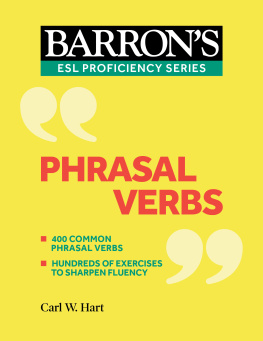

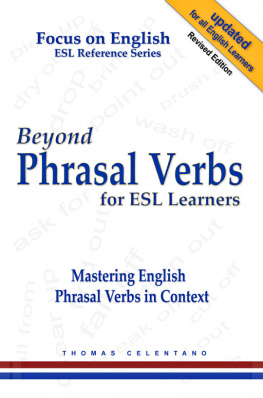
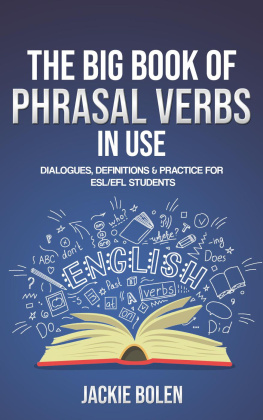
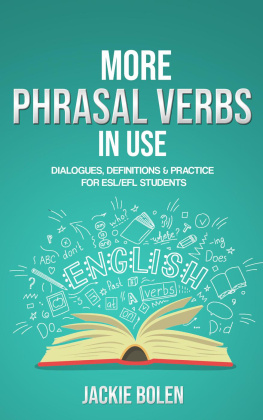

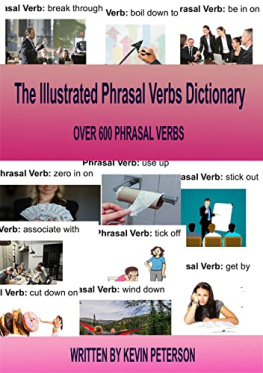
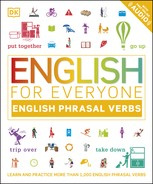





 Copyright 2017, 2009, 1999 by Carl W. Hart All rights reserved. No part of this book may be reproduced or distributed in any form or by any other means without the written permission of the copyright owner. All inquiries should be addressed to: Barrons Educational Series, Inc. 250 Wireless Boulevard Hauppauge, New York 11788 www.barronseduc.com eISBN: 978-1-4380-6879-4 The inspiration for The Ultimate Phrasal Verb Book came about when a student asked me for a textbook to help her learn the meanings of common English verbs. The only textbook focusing on common verbs that I could give her taught the decidedly uncommon verbs arise , awake , and seek but made no mention of their much more common phrasal equivalents get up , wake up , and look for .
Copyright 2017, 2009, 1999 by Carl W. Hart All rights reserved. No part of this book may be reproduced or distributed in any form or by any other means without the written permission of the copyright owner. All inquiries should be addressed to: Barrons Educational Series, Inc. 250 Wireless Boulevard Hauppauge, New York 11788 www.barronseduc.com eISBN: 978-1-4380-6879-4 The inspiration for The Ultimate Phrasal Verb Book came about when a student asked me for a textbook to help her learn the meanings of common English verbs. The only textbook focusing on common verbs that I could give her taught the decidedly uncommon verbs arise , awake , and seek but made no mention of their much more common phrasal equivalents get up , wake up , and look for .